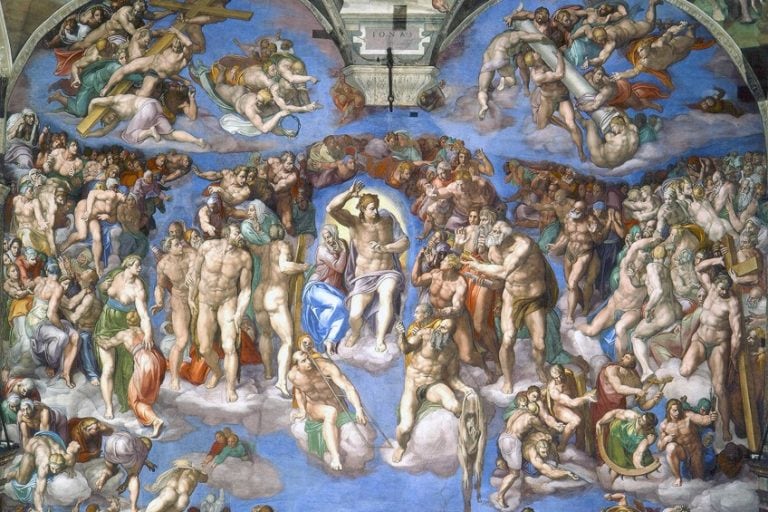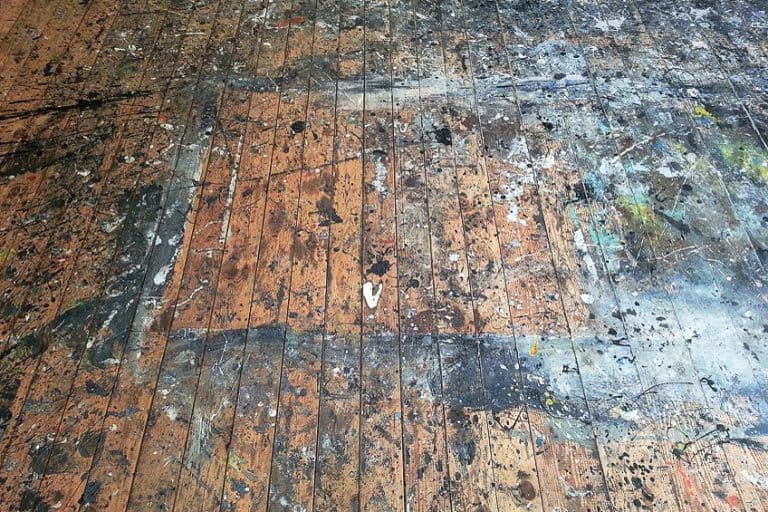“Gin Lane” by William Hogarth – A Visual Analysis of the Work
Imagine a scene filled with the sounds of hysterical laughter, moans, groans, mumbles, murmurs, clashing, and clanking. This is what the print, Gin Lane (1751) by William Hogarth, undoubtedly would sound like. Read more below as this article unpacks the visual cacophony.
Artist Abstract: Who Was William Hogarth?
The English artist William Hogarth was born in London on November 10, 1697, which is also where he died on October 26, 1764. His style of art was Rococo. While he was a skillful artist, from painting to engraving, he was well-known for his prints that depicted satirical stories that often addressed moralistic topics, which were termed his “Modern Moral Subjects”.

His early artistic training included working as an engraver apprentice under Ellis Gamble, studying at St. Martin’s Lane Academy, and studying drawing under Sir James Thornhill. Some of his famous artworks include A Harlot’s Progress (1732), A Rake’s Progress (1734), and Marriage A-la-Mode (1743 – 1745).
Gin Lane (1751) by William Hogarth in Context
| Artist | William Hogarth (1697 – 1764) |
| Date Created | 1751 |
| Medium | Copper plate (engraved) |
| Genre | Genre |
| Period/Movement | Rococo art |
| Dimensions (centimeters) | 39.2 x 32.7 |
| Series/Versions | Part of another engraving titled Beer Street. |
| Where Is It Housed? | The copper plates for Gin Lane and Beer Street are located at the Metropolitan Museum of Art in New York City, United States. |
| What It Is Worth | The copper plates were never sold by Hogarth and reportedly sold after his death. The exact price is uncertain. |
Gin Lane by William Hogarth was created in 1751 as a copper plate engraving and then as a print. It is part of a series of two engravings, its companion piece is the engraving titled Beer Street (1751), of which both illustrate the different effects of consuming these drinks. The article below will reveal more about why Hogarth created these engravings and the socio-historical context. It is important to note, that while this article will discuss both above-mentioned engravings, a formal analysis will specifically explore the engraving Gin Lane in more detail.
Contextual Analysis: A Brief Socio-Historical Overview
Gin Lane by William Hogarth was created as a campaign to raise awareness of the dangers of drinking gin and to support the Gin Act of 1751. But why was gin so dangerous? The answer to this lies in the history of gin in London during the 18th century, which is recalled as the “Gin Craze”.
The Gin Craze started when the production of gin became more widespread and affordable, including amongst the poorer members of society. The reasons point to what is termed “economic protectionism”.
Simply explained, this is when a government encourages domestic trade over international trade to bolster domestic economic growth. This was encouraged by William III, otherwise named William of Orange, who was the Dutch King of England, Scotland, and Ireland and ruled from 1689 to 1702. Gin originated in Holland, the Netherlands.

With gin widely available, the addiction rates increased, and notably amongst the poor, who would drink it as a source of comfort. It was also called “Mother’s Ruin” because women mistreated their children. Some even killed for gin, as was the case of Judith Defour who reportedly killed her daughter.
Although there were previous Gin Acts instated, the Parliament of Great Britain instated the Gin Act of 1751 to minimize the overconsumption of gin and reduce the negative effects it caused.
The laws enacted include that gin sales were prohibited to unlicensed merchants and that more sizable gin manufacturers were allowed to hold licenses. Along with William Hogarth’s friend, Henry Fielding, who was a magistrate and writer, the two published their respective works during the same time. Fielding wrote An Inquiry Into the Late Increase in Robbers (1751), which explored the increased crime rates and the potential causes of it.
Formal Analysis: A Brief Compositional Overview
In the formal analysis below, you will learn more about what the subject matter of the print titled Gin Lane by William Hogarth consists of. An overview of how the formal qualities, in other words, the art elements, arrange the composition will also provide a closer look at the artist’s style and techniques.
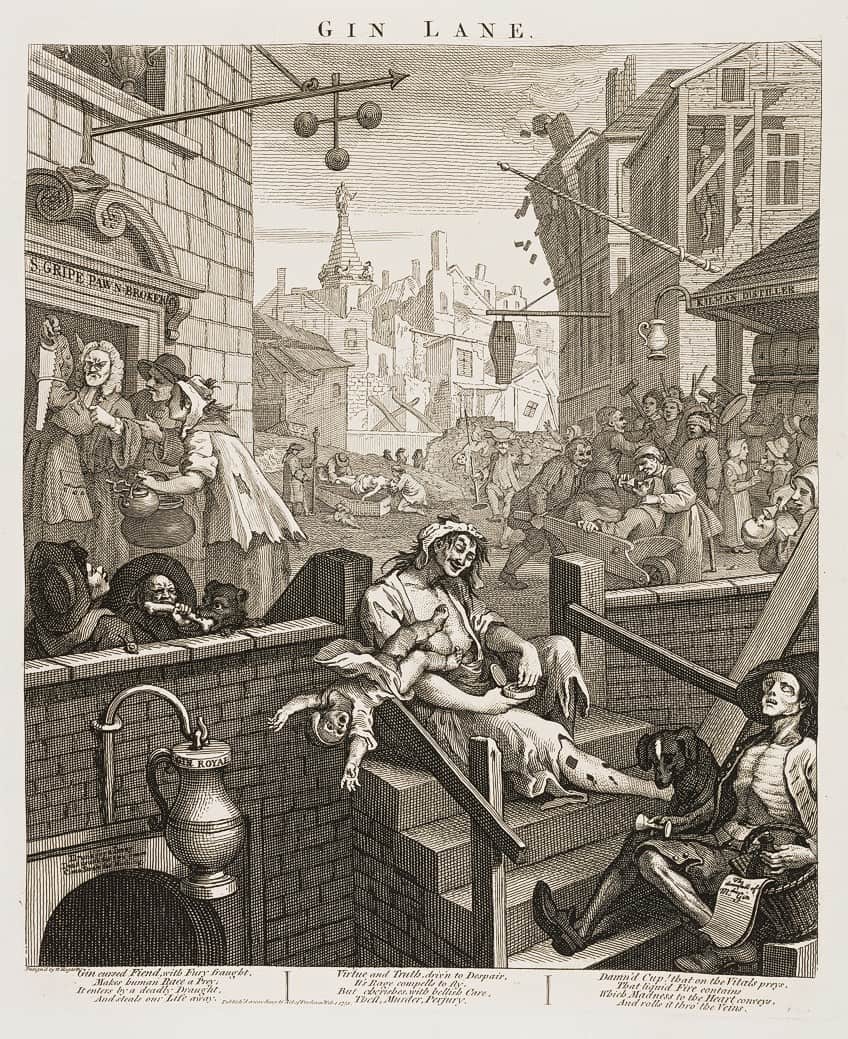
Subject Matter: Visual Description
Gin Lane by William Hogarth depicts a lively scene filled with people going about their business. Although, this is not your typical everyday business. This is the drunken debauchery business of people who have all gone over the edge into apparent madness. The scene takes place in the slum of St. Giles, the West End in London. In the far background is St. George’s Church in Bloomsbury. The lower right corner depicts an emaciated man sitting at the bottom of a stepway, leaning against the railing. He is either asleep or dead.
There is a cup that’s toppled on its side, loosely held in his right hand, and his left hand is holding onto a bottle of gin in a basket. A piece of paper, or possibly pamphlets, hangs out of the basket titled, “The Downfall of Mrs. Gin”. A black dog sits on the man’s right side and appears to be downtrodden as if he just lost his owner. The dog has been described as symbolizing despair.
In the foreground, centrally placed, is a woman sitting at the top of the above-mentioned stairway. She appears raggedy, her breasts are exposed, and there are sores on her outstretched right leg, which have been indicated to be syphilitic sores. She has also been described as a prostitute.
She is busy taking some snuff, with her left hand, from the container held in her right hand, while her baby falls over the stairway railing towards the gin cellar in the lower left corner of the composition. The gin cellar is identified by its name “Gin Royal” on the hanging pitcher and the words over the doorway read, “Drunk for a penny. Dead drunk for two pence. Clean straw for nothing.”
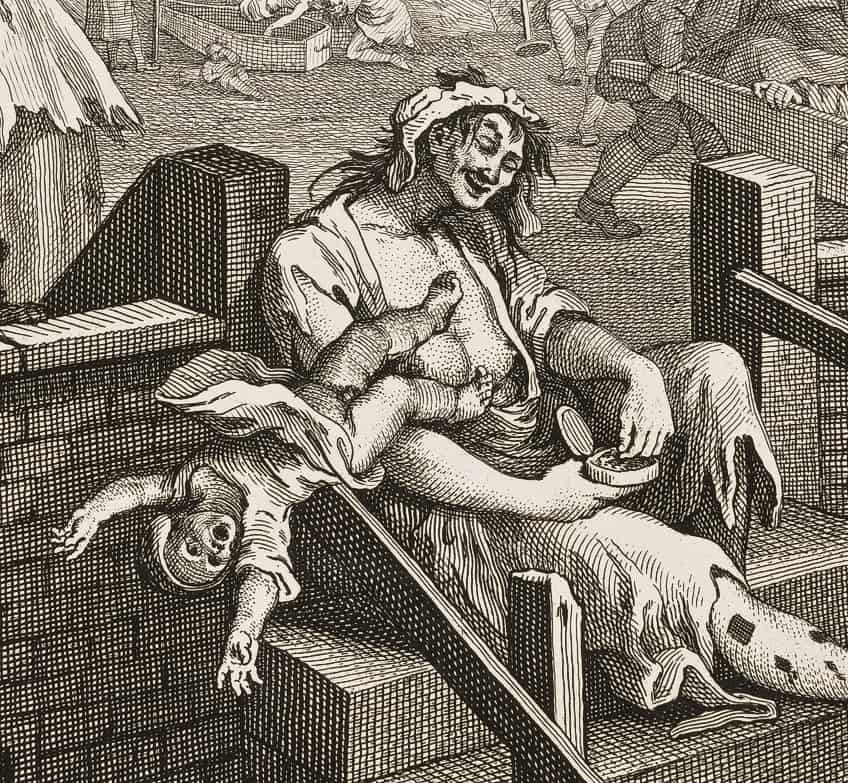
On the left, above the cellar, and what appears to be the next level of the street, are two figures, one of them is chewing on the side of a bone while a dog chews the other side. Next to them is another figure, appearing to be in a stupor or asleep. There is also a snail approaching this figure on the edge of the wall.
Behind them is a building with the words, “S. GRIPE PAWN BROKER”, and three people, one appears to be a pawnbroker and the other two are pawning some of their belongings. The woman holds a pot and kettle in her left hand while the man appears to be pawning his coat and saw.
On the right is a grouping of people by a building with the words “KILMAN DISTILLER” where there are several barrels with numbers on each. Two women are talking to one another with their drinks in hand. There is also a group of men, one is holding up a club while a blindfolded man (he is possibly blind) is holding up a stool or small table. A woman is pouring gin into another woman’s mouth, the latter is sitting in a wheelbarrow pushed by a man. Another woman can be seen feeding gin to her baby, whom she is cradling in her arms.
The background depicts a man facing towards us, the viewers, he appears jolly and holds a bellow on his head with his left hand, and in his right hand is a spike with a baby impaled on it. A hysterical woman can be seen running towards him on his left (our right).

On the left, the dead body of a woman is being placed in a coffin by several figures, and what appears to be her child sitting on the ground crying. Behind this scene and behind a broken-down wall, are several other figures who appear to be walking in a procession. This has been believed to be a funeral procession. On the right are more buildings, broken down and destroyed.
In the building to the right of the Kilman Distillery building is a man who hung himself on the top floor.
There is a caption below the Gin Lane images, which reads: “Gin cursed Fiend, with Fury fraught, Makes human Race a Prey, It enters by a deadly Draught, And steals our Life away. Virtue and Truth, driv’n to Despair, it’s Rage compells to fly, But cherishes, with hellish care, Theft, Murder, Perjury. Damn’d Cup! that on the Vitals preys, That liquid Fire contains, Which Madness to the Heart conveys, And rolls it thro’ the Veins”.
Color and Value
Gin Lane by William Hogarth appears in neutral colors, mostly black and white, or off-white due to it being an engraving, and eventually turned into a print. There are differences in the color scheme compared to a painting, for example. Through techniques like shading and leaving areas open, the artist implied a sense of color. For example, the darker shading of the dog on the right in the foreground suggests it is black.
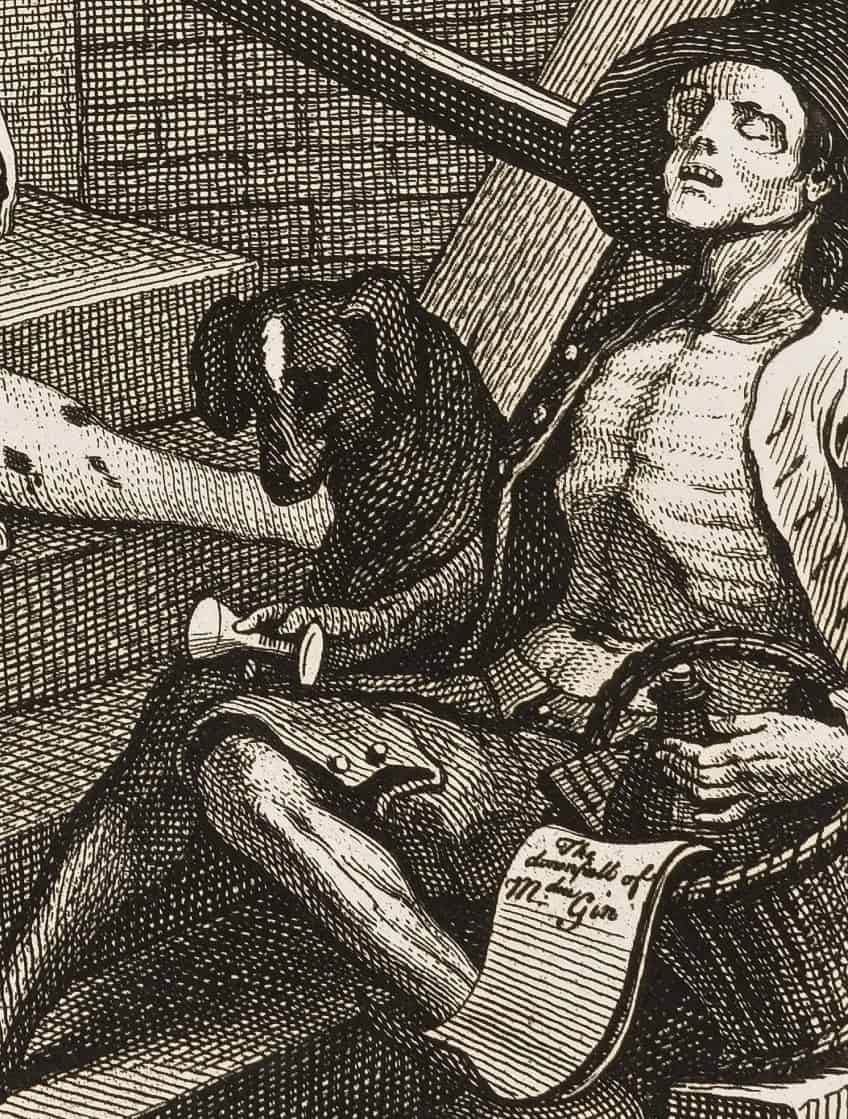
Texture
Texture is implied in Gin Lane by William Hogarth through the application of lines. For example, notice the buildings and coffins that appear hard and the softer textures of the figures’ clothing and its folds.
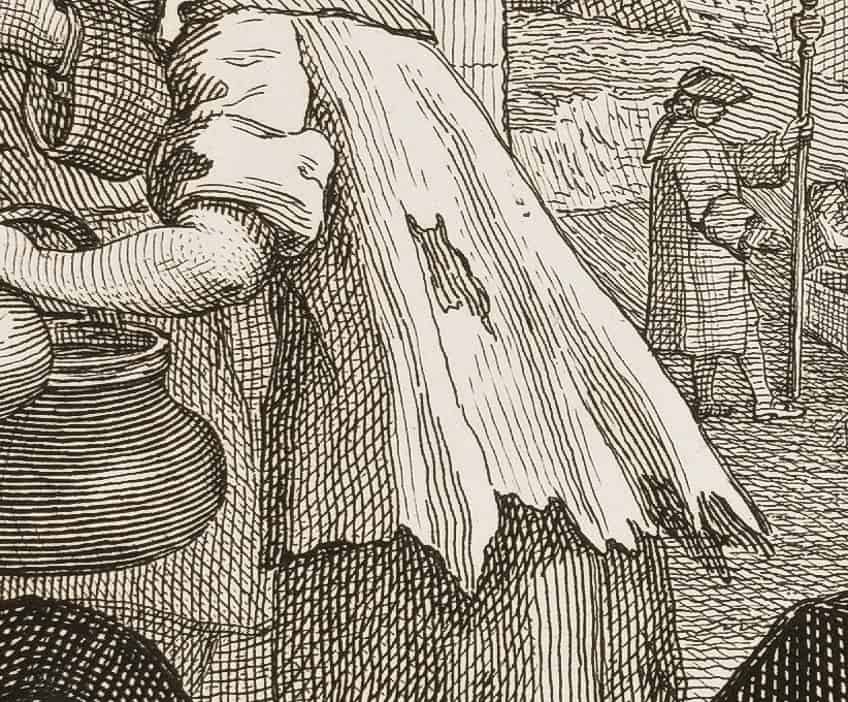
Line
Gin Lane by William Hogarth consists of lines due to it being an etching and engraving. The lines are utilized to create the effects of color and shading, as well as texture. Some of these lines appear short, long, thin, thick, curved, and applied in different directions like horizontal, vertical, and diagonal.
The lines create a dynamism in the scene.

Shape and Form
There is an assortment of shapes and forms in Gin Lane by William Hogarth, from more naturalistic to geometric. Some of the shapes that occur are irregular squares, rectangles, and half triangles for the buildings, which contrast with the more natural forms of the figures and the spherical, bulbous curves of the drinking vessels and hanging pitchers by the cellar and distillery, or the decorative effects of the doorway on the building on the left in the foreground.

Space
Gin Lane by William Hogarth depicts a sense of depth, which is created through shading effects and scale. For example, the figures in the foreground are darker in shading and therefore clearer in view compared to the background, which appears lighter in shading, and some of the figures are smaller in scale, which suggests distance.

A Shock Into Sobriety
While some research William Hogarth’s Gin Lane as the Gin Alley painting, it is important to be aware that it is, in fact, a print from a copper plate engraving, of which both originals are at the Metropolitan Museum of Art in New York, United States.

The Gin Lane and Beer Street prints were widely distributed after their publication and there were reportedly no paintings made of them, but some print variations. The image was also recreated by contemporary artist, Thomas Moore, to raise awareness of modern-day health challenges in his Gin Lane (2016), which was commissioned by the Royal Society for Public Health.
Gin Lane by William Hogarth was a prominent artwork and along with its companion piece, Beer Street, it was part catalyst for the restriction of gin in Britain. Gin Lane illustrated the dangers of what gin drinking did to the population. Gin Lane is a shock to the system as it illustrates a raw reality of what people experienced, but it is also one of the many examples of the artist’s ability to address abrasive and sensitive subject matter.
Frequently Asked Questions
Who Made the Famous Gin Alley Painting?
The Gin Alley painting is titled Gin Lane, and it is an etching and engraving by the Rococo artist William Hogarth. It was created in 1751 and was reproduced as prints.
Is Gin Lane by William Hogarth Part of a Series?
Gin Lane (1751) by William Hogarth is part of a set of two etchings and engravings. The counterpart is titled Beer Street (1751). Both depict the dramatized effects that drinking beer (positive and jolly) and gin (debaucherous and destructive) has on the population.
What Does Gin Lane by William Hogarth Mean?
Gin Lane (1751) by William Hogarth is an illustration of the destructive and ruinous effects of gin, and brings awareness to how the poorer classes became addicted to the alcoholic spirit to the point of death.
Alicia du Plessis is a multidisciplinary writer. She completed her Bachelor of Arts degree, majoring in Art History and Classical Civilization, as well as two Honors, namely, in Art History and Education and Development, at the University of KwaZulu-Natal, South Africa. For her main Honors project in Art History, she explored perceptions of the San Bushmen’s identity and the concept of the “Other”. She has also looked at the use of photography in art and how it has been used to portray people’s lives.
Alicia’s other areas of interest in Art History include the process of writing about Art History and how to analyze paintings. Some of her favorite art movements include Impressionism and German Expressionism. She is yet to complete her Masters in Art History (she would like to do this abroad in Europe) having given it some time to first develop more professional experience with the interest to one day lecture it too.
Alicia has been working for artincontext.com since 2021 as an author and art history expert. She has specialized in painting analysis and is covering most of our painting analysis.
Learn more about Alicia du Plessis and the Art in Context Team.
Cite this Article
Alicia, du Plessis, ““Gin Lane” by William Hogarth – A Visual Analysis of the Work.” Art in Context. December 29, 2023. URL: https://artincontext.org/gin-lane-by-william-hogarth/
du Plessis, A. (2023, 29 December). “Gin Lane” by William Hogarth – A Visual Analysis of the Work. Art in Context. https://artincontext.org/gin-lane-by-william-hogarth/
du Plessis, Alicia. ““Gin Lane” by William Hogarth – A Visual Analysis of the Work.” Art in Context, December 29, 2023. https://artincontext.org/gin-lane-by-william-hogarth/.





